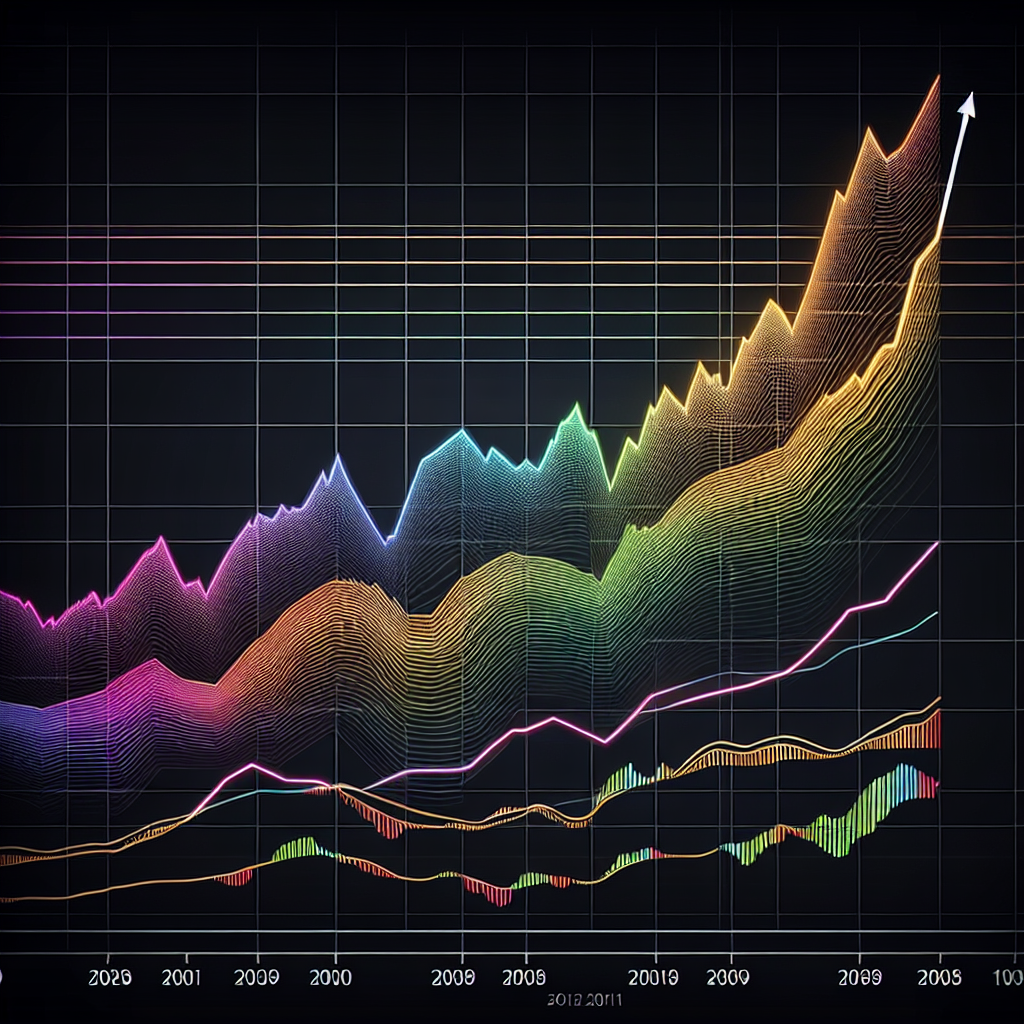In November, the stock market had a really good week after a bad month. The Nasdaq 100, which is a group of companies that focus on technology and innovation, did really well and helped push the market up. The S&P 500 and the Dow Jones, which are other groups of companies that represent the whole stock market, also went up. Some people think this is because the Federal Reserve, which helps control the economy, is done with raising interest rates. Another reason is that a special kind of fund called the Invesco QQQ Trust and the S&P 500 did really well. It’s also interesting to see that the companies focused on growth and new ideas are doing better than the companies focused on value and stability.

Nasdaq 100 Drives Market Gains
The stock market experienced a period of gains, with the growth-heavy Nasdaq 100 leading the charge. The Nasdaq 100 index is composed of companies primarily in the technology, biotechnology, and internet sectors. These sectors have seen significant growth in recent years, attracting investors looking for high returns.
The Nasdaq 100’s performance was driven by the strong performance of companies within the index. Tech giants like Apple, Amazon, Microsoft, and Google have been leading the way with their innovative products and services. These companies have seen increased demand and have been able to capitalize on the digital revolution.
Analysts and traders have become more optimistic about the market as a result of the Nasdaq 100’s performance. They believe that the strong performance of these growth stocks indicates a healthy market and a positive outlook for the future. This optimism has led to increased investor sentiment and a willingness to invest in the market.
One of the top performers in the market gains was the Invesco QQQ Trust (QQQ), an exchange-traded fund (ETF) that tracks the performance of the Nasdaq 100. The QQQ has seen significant gains as a result of the strong performance of the companies within the index. This ETF allows investors to gain exposure to a diversified portfolio of growth stocks, which has been a key factor in its success.
In addition to the QQQ, the S&P 500, which represents a broader range of companies across various sectors, also performed well during this period of market gains. The S&P 500 saw increased investor optimism as well, indicating a positive outlook for the overall market.
S&P 500 Follows Nasdaq 100
The S&P 500, a widely followed index that measures the performance of 500 large-cap companies, also experienced positive gains during this period. The index includes companies from various sectors, providing a more comprehensive view of the overall market performance.
Investor optimism for the S&P 500 increased as a result of its strong performance. Many investors see the S&P 500 as a reliable indicator of the overall health of the stock market. When the index performs well, it is often seen as a positive sign for the market as a whole.
The performance of the S&P 500 is influenced by the performance of its constituent companies. During the market gains, many of the companies within the index saw increased demand for their products and services, leading to higher stock prices. This positive performance contributed to the overall gains of the index.
Investors continue to have a positive outlook for the S&P 500, expecting it to perform well in the coming months. This optimism is based on a combination of factors, including the strong performance of the companies within the index and the overall positive sentiment in the market.
Dow Jones Trails behind Nasdaq 100 and S&P 500
While the Nasdaq 100 and S&P 500 experienced significant gains during this period, the Dow Jones Industrial Average (DJIA) lagged behind. The Dow Jones is composed of 30 large-cap companies from various sectors, including retail, healthcare, and financial services.
The slower growth of the Dow Jones can be attributed to a combination of factors. One factor is the composition of the index itself. The Dow Jones includes companies from a wide range of sectors, some of which may not have performed as well as the technology and growth sectors represented in the Nasdaq 100 and S&P 500.
Additionally, the Dow Jones may have been affected by external factors such as changes in interest rates or geopolitical events. These factors can have a significant impact on the performance of the companies within the index and, consequently, the overall performance of the index itself.
While the Dow Jones may have trailed behind the Nasdaq 100 and S&P 500 during this period, it is important to note that market performance can vary over time. Investors should consider a diversified portfolio that includes exposure to different sectors and indices to mitigate risk and take advantage of potential opportunities.
Stock Market Rebounds after October Decline
After a period of decline in October, the stock market experienced a rebound with a five-day rally in November. This rally brought hope to investors who were concerned about the market’s performance.
The rebound in the stock market can be attributed to a combination of factors. One factor is the overall strength of the economy. Despite some concerns about global trade tensions and geopolitical uncertainties, the U.S. economy has been performing well, with low unemployment rates and steady economic growth.
Another factor contributing to the market rebound is the positive sentiment among investors. The American Association of Individual Investors reported that the number of investors expecting the S&P 500 to move higher in the next six months significantly increased. This increased optimism is likely driven by the strong performance of the Nasdaq 100 and S&P 500, as well as positive economic indicators.
The stock market’s rebound is an encouraging sign for investors. While market performance can fluctuate, this period of gains provides reassurance that the market has the potential for growth and presents investment opportunities.

Investors’ Optimism in the S&P 500
Investors’ expectations for the S&P 500 have seen a notable increase during the period of market gains. This optimism is driven by several factors.
Firstly, the strong performance of the companies within the S&P 500 has contributed to increased investor confidence. Many of these companies have reported positive earnings and have demonstrated their ability to navigate challenging market conditions.
Additionally, investors’ optimism is influenced by the overall positive sentiment in the market. When the stock market experiences gains, it often signals a healthy market environment and a positive outlook for the future. This positive sentiment spreads among investors, leading to increased expectations for continued growth.
Furthermore, the S&P 500 is widely regarded as a benchmark index for the overall market performance. When the index performs well, it is seen as an indicator that the stock market is in a positive state. This perception further boosts investor optimism and contributes to increased expectations for the S&P 500.
Overall, the investors’ optimism in the S&P 500 is driven by a combination of factors, including the strong performance of its constituent companies, positive market sentiment, and the index’s reputation as a reliable indicator of the overall market health.
Growth Stocks Outperform Value Stocks
During the period of market gains, growth stocks demonstrated their superiority over value stocks. Growth stocks are characterized by companies that are experiencing rapid expansion and are expected to continue growing at an above-average rate. Value stocks, on the other hand, are seen as undervalued and have the potential for long-term growth.
The iShares Russell 1000 ETFs provide a good representation of the performance of growth and value stocks. The growth iShares Russell 1000 (IWF) recorded a 3% gain during this period, while the value iShares Russell 1000 (IWD) declined by 1%.
The outperformance of growth stocks can be attributed to several factors. Firstly, the ongoing digital revolution has created significant opportunities for growth companies, particularly in the technology and internet sectors. These companies have been able to capitalize on the increasing demand for their products and services, driving their stock prices higher.
Additionally, growth stocks tend to attract more investor interest during periods of market gains. Investors are willing to take on more risk in search of higher returns, making growth stocks an attractive option. On the other hand, value stocks may be seen as less desirable during such periods, as investors opt for the potential for faster growth.
It is important to note that different market conditions can favor either growth or value stocks. Investors should consider diversifying their portfolios to include a mix of both types of stocks to mitigate risk and take advantage of potential opportunities in the market.
QQQ Outperforms and Breaks Downtrend
The Invesco QQQ Trust (QQQ) has shown significant outperformance during the period of market gains. The QQQ is an exchange-traded fund (ETF) that tracks the performance of the Nasdaq 100 index.
The QQQ’s outperformance can be attributed to the strong performance of the companies within the index. Many of these companies are technology and growth-focused, which have been experiencing rapid expansion. As a result, the QQQ has been able to generate higher returns for investors.
Furthermore, the QQQ has broken its downtrend from the summer highs. A downtrend refers to a period of declining prices over a given time frame. The QQQ’s ability to break its downtrend indicates a potential shift in market sentiment and an improved outlook for the index.
Investors who hold the QQQ have benefited from its strong performance and the ability to gain exposure to a diversified portfolio of growth stocks. The ETF provides an efficient way to invest in the Nasdaq 100 without having to buy individual stocks, allowing investors to reap the benefits of the index’s performance.
SPY Remains below Downtrend
In contrast to the QQQ, the S&P 500 (SPY) has remained below its downtrend from the summer highs during this period. The SPY is an ETF that tracks the performance of the S&P 500 index.
The SPY’s ability to break its downtrend is a significant indicator for investors. A downtrend suggests a period of decline in prices, indicating a negative sentiment in the market. The fact that the SPY has remained below its downtrend indicates that the market sentiment is still cautious, despite the recent gains.
Analysts closely monitor the performance of the SPY to gauge the overall health of the stock market. Its ability to break its downtrend will be important to watch in the coming months, as it will provide insights into the direction the market may take.
It is worth noting that market performance can be influenced by various factors, including economic conditions, geopolitical events, and investor sentiment. Investors should take these factors into consideration when making investment decisions and monitor the performance of key market indices, like the SPY, for potential opportunities.
Factors Influencing Market Gains
Several factors have influenced the recent market gains. Firstly, the Federal Reserve’s stance on interest rates has had a significant impact. The Federal Reserve, the central bank of the United States, has indicated that it is done raising interest rates for the time being. This announcement has reassured investors and eased concerns about the potential impact of higher interest rates on economic growth and corporate profits.
Additionally, the performance of key market indices, such as the Nasdaq 100 and S&P 500, has contributed to market gains. These indices consist of companies from sectors that have experienced rapid growth, such as technology and healthcare. The strong performance of these companies has attracted investor interest and contributed to the overall gains in the market.
The perspective of analysts and traders has also had an impact on market gains. Analysts closely monitor market conditions and company performance to provide insights and recommendations to investors. Traders, on the other hand, make buying and selling decisions based on market trends and opportunities. The optimistic views of analysts and traders have contributed to investor sentiment and increased expectations for market gains.
It is important to note that market performance can be influenced by various factors and can change over time. Investors should closely monitor these factors and seek professional advice when making investment decisions to navigate the market effectively.
Continued Outperformance of Growth Stocks
The period of market gains has highlighted the continued outperformance of growth stocks compared to value stocks. This trend has important implications for investors and market dynamics.
Growth stocks have continued to outperform due to their strong fundamentals and market demand. Companies in the technology, biotechnology, and internet sectors, among others, have been experiencing rapid growth and have been able to capitalize on market opportunities. This has driven up their stock prices and attracted investor interest.
The outperformance of growth stocks can also be attributed to the ongoing digital revolution. As technology continues to evolve, companies in this sector are positioned to benefit from changing consumer behaviors and preferences. The global shift towards a digital economy has created significant opportunities for growth companies, providing a favorable environment for their continued outperformance.
The implications of the continued outperformance of growth stocks are twofold. Firstly, it suggests that investors are willing to take on more risk in search of higher returns. Growth stocks are often seen as riskier investments due to their higher valuations and potential for volatility. However, the strong performance of these stocks indicates that investors are confident in their long-term growth potential.
Secondly, the outperformance of growth stocks can influence market dynamics. As more investors flock to growth stocks, their prices may continue to rise, creating positive market sentiment and attracting further investment. This can create a cycle of increasing demand and higher stock prices, providing further opportunities for growth companies and investors alike.
In conclusion, the stock market experienced a period of gains driven by the growth-heavy Nasdaq 100, followed by the S&P 500. The performance of these indices and the outperformance of growth stocks have contributed to investor optimism and market gains. Factors such as the Federal Reserve’s stance on interest rates, the performance of key market indices, and analyst and trader perspectives have influenced these gains. As investors continue to navigate the stock market, it is important to monitor market conditions and seek professional advice to optimize investment decisions and take advantage of potential opportunities.
Source: https://www.forbes.com/sites/tomaspray/2023/11/12/sentiment-shifts-blue-sky-ahead/

